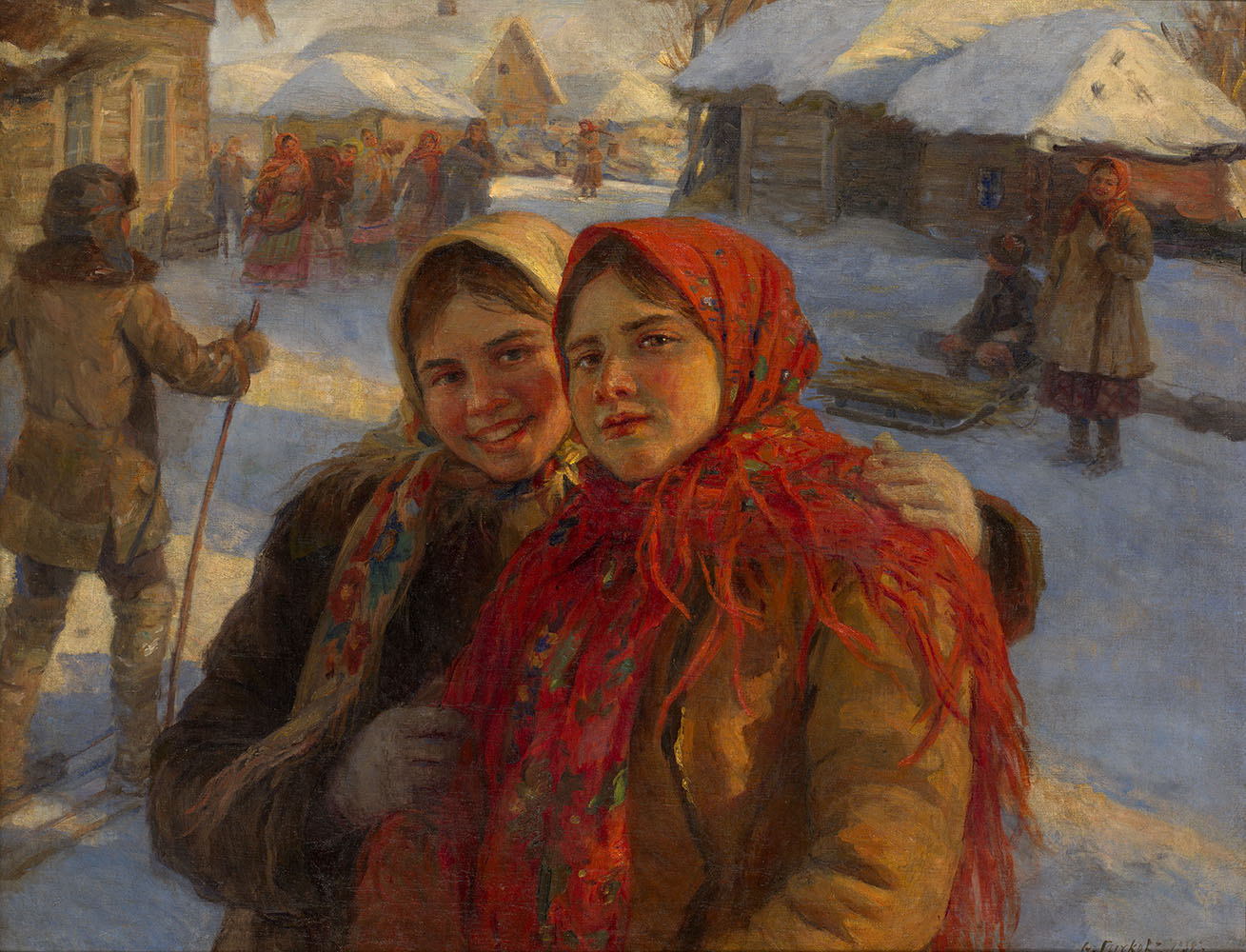MacDougall Auctions 2-3 December 2009
2 December 2009

* 225. SYCHKOV, FEODOR 1870-1958
Best Friends signed and dated 1938
Oil on canvas, 71 by 92 cm.
150,000-200,000 pounds
Authenticity certificate from Vladimir Petrov.
The theme of “the friendship of little girls’ hearts”, as the artist described it, was one of the greatest achievements of Feodor Sychkov’s work. He created a whole series of folk images of children that captivate with the spontaneity of feeling and spiritual beauty. Sychkov’s “female friends” are depicted in a variety of settings and pursuits: now sitting on a fence, with a sunflower and a twig in their hands; now leaning against a fence on a winter’s day; now cosily standing shoulder to shoulder, dressed in their national costume; and now hugging one another under a tree in springtime. Village kids adored the artist. As soon as he appeared on the street, a whole horde of children would immediately surround him. For every single one of them the artist had a kind word or a lolly, as well as a minute for a short sketch.
The artist’s images of children had already brought him huge popularity by the early 1900s. Unlike many salon artists who would from time to time produce clear fabrications of folk life, Sychkov succeeded in preserving a balance between beauty and reality and in avoiding sentimentality and deception. Critics observed that Sychkov “improved Salon painting by attempting not to depict his ‘girls’ as pretty models, but rather to discern certain character types in them”. His works were highly sought after all over Russia. They were purchased by the intelligentsia, grand princes, rich industrialists, famous collectors (for example, S.M. Tretyakov, brother of the famous founder of the Tretyakov gallery), renowned architects and artists, the imperial court and foreign museums.
After the Revolution, Sychkov returned to his native Mordovian village of Kochelayevo, fleeing the turmoil of Petrograd, where his studio had been pillaged. There, he focused fully on portraying children and adolescents, particularly girls. During this period he mainly created versions or copies of his early, pre-Revolutionary works: The Little Friends (1920), Spring (1926), The Holiday (1927), The Holiday. Friends. Winter (1929), and a series of other works. However, even against a background of such benchmark canvases, the work Best Friends (1938) stands out as a clear triumph for the artist in terms of both composition and colour.
Two pretty, slightly mischievous girls in their bright shawls and weather-beaten sheepskin coats are standing in the middle of a street as if they have only just torn themselves away from the Maslenitsa festivities in which the rest of their fellow villagers are engaged – those of noisy games, ice skating, and skiing. The girl in the centre in a red dressy shawl, her smiling friend to her left who is tilting her head coquettishly, the crowd of young peasant women in national dress who have poured into the street, and the little lad tottering on skis – everything on the painting captivates with the blossoming vigour of youth and sheer joy of human existence. We see before us the artist’s favourite subjects – strongly built, ruddy, and smiling peasant girls gazing upon the viewer teasingly, with unconcealed curiosity, sincerity and openness. This was Sychkov’s ideal, which may be far from perfect beauty; however, the artist was looking for something else in his models: that internal fire and buoyant love for life that lights up the faces of his heroines with an invariably merry smile.
This work reveals the talent of the artist, who as a painter of everyday life of the Russian countryside knew not only how to depict bright folk characters but also how to embody his ideal of national and physical beauty in the images of common rural people. Sychkov preferred to paint Russian villagers during their holidays, and his understanding of the beauty and joyfulness of folk life brings him close to such painters as Bogdanov-Belsky, Surikov, Maliavin and Kustodiev.
Each portrait was preceded by a lot of studies. Fellow villagers of Kochelayevo remember how Sychkov’s girl models who were posing for him outside in the freezing cold would have to run into their houses every quarter of an hour to warm their numb hands on the stove and then get back to the artist who would in the meantime be waiting for them impatiently, eager to make use of every minute of a short winter day. As the painting took shape, expressiveness of the sketches which manifested the artist’s delight at engaging with people and places so dear to his heart, would become more subtle and subdued. This impulsiveness and spontaneity in executing a composition which looks so real, truly reveals Sychkov’s talent and artistic distinctiveness.
The artist masterfully sculpts the girls’ faces with patches of light and shadow, whereby their images are revealed with a particular reverence. Winter landscape, so skilfully depicted by the artist, also plays a crucial part here. The girls’ images merge harmoniously with the image of Russian winter, with its pure white snow, or bluish shadows cast by the blazing sun.
Best Friends is in a sense the creative credo of the artist, who believed that “In life, there must be as much joy as possible. Joy is the sign of happiness of the people. It is the source of liveleness, energy and health. It is the first aide in labour big and small, cure for each ailment and ally in each misfortune.”
Notes on symbols:
* Indicates 5% Import Duty Charge applies.
Ω Indicates 20% Import Duty Charge applies.
§ Indicates Artist's Resale Right applies.
† Indicates Standard VAT scheme applies, and the rate of 20% VAT will be charged on both hammer price and premium.